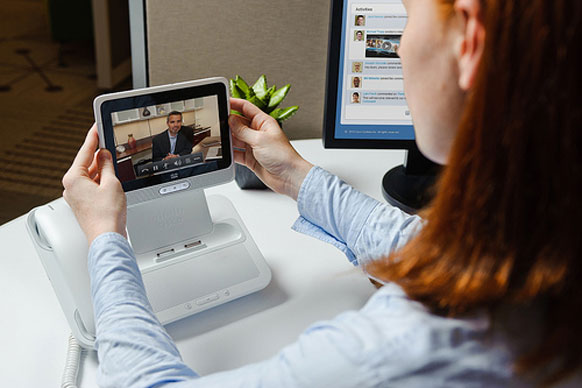A Tablet that Wants to Take Over the Desktop
The latest entrant in the increasingly crowded tablet computing field, Cisco’s Cius, is bulkier than the iPad, and has a smaller screen (7 inches diagonally, compared to the iPad’s 9.7). But it packs a number of tricks all of its own, designed to woo business users. The Cius is designed to integrate closely with Cisco’s voice and video phone systems, and it can even replace a desktop computer when docked to a new Cisco desk phone, which connects to a monitor, keyboard and mouse.
A Cius tablet makes a user’s desk number mobile, enabling people to make and receive voice and video calls anywhere, if their company has a Cisco phone system. The tablet features HD-quality cameras in front and in back and can be used with a Bluetooth headset for more private calling. The tablet can also be used as a desktop videoconferencing device when docked on a special desktop phone, and can smoothly switch between a Wi-Fi and cellular network connection.
That dock can also be plugged into a monitor keyboard and mouse to act like a desktop computer. “It can replace my desktop operating system,” says Tom Puorro, senior director for Cisco’s collaboration technologies.
The Cius runs Google’s Android mobile operating system, which is used on a rapidly growing number of smart phones and tablets as well. Android is open source, meaning it can be modified by anyone for free, yet so far most companies that have built gadgets running Android have tinkered with it little. The Cius, in contrast, features a radical reworking of Android.
This gives an IT department much greater control over what a Cius user can do. IT managers can shut down access to the Android app market to protect a company from malicious apps. Cisco has also created its own app store, AppHQ, that contains only apps deemed stable and secure by Cisco. Companies can even create their own app store within AppHQ and limit employees to certain applications, or apps built in house.
A Wi-Fi-only version of the tablet will be available worldwide from July 31 at an estimated price of $750. Cisco will sell it along with related services and infrastructure, so the cost to businesses will vary, and could be as low as $650. AT&T and Verizon will each offer versions for their 4G networks this fall.
A person can use the tablet’s own OS or Windows even via a virtual desktop that runs in the cloud, as Puorro demonstrated at a launch event held in San Jose today. The tablet’s powerful 1.6GHz Intel Atom processor allows desktop-like performance when hooked up to a keyboard, mouse and monitor. Although iPads are showing up in workplaces, they can’t offer the same integration with everyday tasks like phone calls, and are limited to e-mail, Web browsing and video, says Puorro.
Cisco worked with Google to get advice on its modifications to Android, says Puorro. These modifications enable Android to deal with video and operations like group calling and transferring calls, and make use of a dedicated chip in the tablet that encrypt all its data.


However, the Cius lags other Android tablets in that it uses a now-outdated version of the operating system, code-named FroYo, which was intended only for phones. Cisco say they will catch up, but are waiting for the fall release of Android, code-named Ice Cream Sandwich, a version that Google says will seamlessly span phones and tablets.
Ken Dulaney, a VP and analyst with Gartner specializing in mobile devices, says that Cisco has likely delivered something that none of the 200 or so other tablets launching this year can match. “Samsung’s latest Galaxy Tab has much more advanced hardware,” he says, “what Cisco has done is create a special case of Android that adds things the enterprise needs and is a unique combination of phone, tablet and videoconferencing device.”
Other companies have hinted at plans for enterprise-friendly revamps of Android, says Dulaney, including Motorola, but none have so far yet delivered.
Although the Cius may not seem competitive with Apple’s iPad 2 to consumers, to businesses concerned about their security it likely has distinct advantages. Apps such as MobileIron exist to help IT staff control iPads, but Apple’s operating system fundamentally limits the extent to which the iPad can be managed remotely, says Dulaney. “With Android, Cisco could go in at a low level and change how the device is managed so a company can manage everything for the user.”
Without an existing investment in Cisco phone and communication systems, though, many company may see little appeal. Puorro says that Cisco continues to develop and release iPad and iPhone apps for its collaboration software, a strategy Dulaney says is wise. “Of course Cisco will also aggressively support iPads,” he says. “I think they’re going to see how the Cius does, and if it doesn’t work out, work hard to support the most popular tablets.”
Keep Reading
Most Popular
Large language models can do jaw-dropping things. But nobody knows exactly why.
And that's a problem. Figuring it out is one of the biggest scientific puzzles of our time and a crucial step towards controlling more powerful future models.
The problem with plug-in hybrids? Their drivers.
Plug-in hybrids are often sold as a transition to EVs, but new data from Europe shows we’re still underestimating the emissions they produce.
Google DeepMind’s new generative model makes Super Mario–like games from scratch
Genie learns how to control games by watching hours and hours of video. It could help train next-gen robots too.
How scientists traced a mysterious covid case back to six toilets
When wastewater surveillance turns into a hunt for a single infected individual, the ethics get tricky.
Stay connected
Get the latest updates from
MIT Technology Review
Discover special offers, top stories, upcoming events, and more.